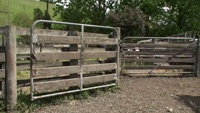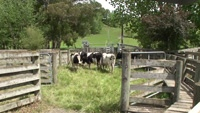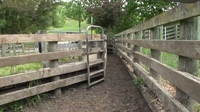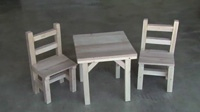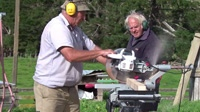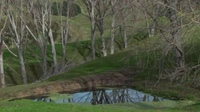Document Library: Poplar Information
An index to our poplar and willow documentation
Filter by topic:
Bee Nutrition |
Breeding, Reports |
Diseases, Rust |
Effluent Management |
Erosion Control, Farms, Rivers, Root Systems |
Fodder |
Cultivation, Irrigation, Nutrition |
Pests, Willow Aphid, Willow Sawfly |
Purchasing Poles |
Trees for the Farm |
Poplars |
Willows |
Timber, Milling uses |
Identification Keys
Filter by document type:
Research Briefs |
Fact Sheets |
Videos |
Publications |
Presentations |
Posters |
Newsletters |
Keys
Pole planting of poplar and willows for erosion prevention on Wairarapa farms
Pole planting of poplars and willows is one of the ways Greater Wellington helps to prevent erosion. Almost one million trees, shrubs and grasses will be planted across the Wellington Region in 2023.
Topics:
Erosion Control;
Poplar Information;
Willow Information;
Document Type:
Videos;
Report 2 for FGLT
Allan Frazer, Ian McIvor
A report for the Forest Growers Levy Trust Project.
The extent of NZ poplar plantations, silviculture, marketing and local use of poplar timber.
Establishment of a Poplar Action Group within NZ Farm Forestry Association (NZFFA).
‘Stage one of a three stage review and analysis of the potential of poplars as commercial timber species in New Zealand.’
Topics:
Poplar Information;
Timber;
Document Type:
Publications;
Report 1 for FGLT: Poplar Cultivation
Ian McIvor
A report for the Forest Growers Levy Trust Project.
Poplar cultivation: a comparison of international and national activity.
The extent of NZ poplar plantations, silviculture, marketing and local use of poplar timber.
Topics:
Poplar Information;
Timber;
Document Type:
Publications;
How poplar trees influence water flow on slopes - Research Brief 19
Water flow on pastoral slopes following rainfall transfers sediment and contributes to slope erosion. Pasture cover reduces flow rate allowing more time for water absorption. Trees also influence water flow in ways that complement and enhance the effect of pasture.
Topics:
Erosion Control;
Farms;
Poplar Information;
Trees for the Farm;
Document Type:
Research Briefs;
Performance of plantation poplar on the Rakaia River in Mid-Canterbury - Research Brief 18
This research brief reports on the performance
of poplar clones in a trial established in 1990 by Environment Canterbury on the banks of the Rakaia River. The trial was to compare the performance of five New Zealand-bred poplar clones, with the ‘Veronese’ (Populus deltoides × P. nigra) poplar clone.
Topics:
Poplar Information;
Trees for the Farm;
Timber;
Document Type:
Research Briefs;
Do I pollard my poplars? - Research Brief 17
What is pollarding? Pollarding is reducing a tree to a stump by removing all branches. For poplars on farms the stump is left at 2 m height so animals cannot eat off the new shoots.
Topics:
Cultivation;
Poplar Information;
Trees for the Farm;
Document Type:
Research Briefs;
Effect of fertilization on growth of poplars established from poles on farmland - Research Brief 16
A single deposit of fertiliser, either N (80g urea), P (180g superphosphate) or both was supplied at 30 cm upslope of the pole and at 15 cm depth to ‘Veronese’ poplar trees on sloping pastoral land two months after the trees were planted as poles.
Topics:
Cultivation;
Nutrition and Fertiliser;
Poplar Information;
Trees for the Farm;
Document Type:
Research Briefs;
Pollarding wide-spaced poplar trees on pastoral hillslopes alters root development - Research Brief 15
Water flow on pastoral slopes following rainfall transfers sediment and contributes to slope erosion. Pasture cover reduces flow rate allowing more time for water absorption. Trees also influence water flow in ways that complement and enhance the effect of pasture.
Topics:
Erosion Control;
Farms;
Poplar Information;
Trees for the Farm;
Document Type:
Research Briefs;
Root development in poplar and willow clones (a pot study) - Research Brief 05
A range of willow (Salix) and poplar (Populus) clones
were used in the study. This information is important for river engineers, land managers and landowners seeking to match planting material to situation.
Topics:
Erosion Control;
Rivers;
Root Systems;
Poplar Information;
Willow Information;
Document Type:
Research Briefs;
Influence of tree shading by Populus ×euramericana ‘Veronese’ - Research Brief 02
We measured and modelled pasture production over a 10-month period under poplar trees aged either 11 or 22 years (TP) and in open pasture (OP), to determine the effect of spaced conservation trees on pasture production.
Topics:
Fodder;
Cultivation;
Poplar Information;
Trees for the Farm;
Document Type:
Research Briefs;
Wood production of ’Kawa’ poplar in an agroforestry trial - Research Brief 14
Poplar is widely planted internationally as a forestry and agroforestry species. The poplar cultivar ‘Kawa’ has been planted in Northland as an agroforestry tree. ‘Kawa’ has a higher wood density than most other poplar cultivars, with a straight stem.
Topics:
Poplar Information;
Trees for the Farm;
Timber;
Document Type:
Research Briefs;
Effect of slope position on poplar growth - Research Brief 13
Trunk diameter data from two wide spaced poplar trials planted in rows, with within row spacing of 10 m, at 20 m apart up a slope are used to provide insights into how slope position affects poplar growth.
Topics:
Erosion Control;
Root Systems;
Cultivation;
Poplar Information;
Trees for the Farm;
Document Type:
Research Briefs;
Influence of soil type on poplar root development - Research Brief 12
Poplar (Populus deltoides × nigra) Trees were grown from 3 m-long poles on pastoral hill slopes in three different soil types, pumice, sandy loam and clay loam, differing in their bulk density.
Topics:
Erosion Control;
Root Systems;
Cultivation;
Poplar Information;
Document Type:
Research Briefs;
Willows, poplars and fodder - Research Brief 10
Poplar and willow provide fodder of sufficient quality and quantity to warrant using then as supplements for feeding to livestock during summer droughts. In addition to the feed quality, the tannins and phenolic glucosides present in the leaves provide pharmaceuticals benefits to stock.
Topics:
Fodder;
Poplar Information;
Willow Information;
Trees for the Farm;
Document Type:
Research Briefs;
Milling poplar on the farm for fencing and yards construction - Research Brief 09
Farm milled poplar provides valuable wood products for both on-farm and off-farm use e.g. treated posts, battens and timber. On-farm, the timber was used for railings and gates in both cattle and sheep yards.
Topics:
Poplar Information;
Trees for the Farm;
Timber;
Farm milling & uses;
Document Type:
Research Briefs;
Newsletter - August 2022
The Poplar and Willow Research Trust August 2022 newsletter
Topics:
Poplar Information;
Willow Information;
Trees for the Farm;
Document Type:
Newsletters;
Poplar trees and soil properties - Research Brief - 07
This study investigated the effects of poplar tree spacing on soil properties (infiltration rate, bulk density, soil moisture content and soil organic matter content) in two Nelder tree plots, with different soil types.
Topics:
Cultivation;
Poplar Information;
Trees for the Farm;
Document Type:
Research Briefs;
Climate change and growth of Poplar and Willow trees - Research Brief 04
We evaluated the response of Populus and Salix trees to elevated carbon dioxide (CO2) and temperature, and the interaction of these factors with drought, in a controlled environment.
Topics:
Poplar Information;
Willow Information;
Trees for the Farm;
Document Type:
Research Briefs;
Killing old Poplar trees using chemicals - Research Brief 03
Large or old poplar trees considered a safety risk can be poisoned, killed and left standing, using an appropriate herbicide applied to the conducting tissue in the trunk.
Topics:
Poplar Information;
Document Type:
Research Briefs;
Poplars and Willows as soil conservation trees in New Zealand - Research Brief 01
This study investigated farmers’ perspectives and experiences of poplar and willow trees planted on their farms for erosion reduction.
Topics:
Erosion Control;
Poplar Information;
Willow Information;
Trees for the Farm;
Document Type:
Research Briefs;
Factsheet 7: Poplar Sawfly: Cladius grandis
Have you seen this unusual insect on your poplar trees? If you have spotted it we want to know! There are no other yellow/ orange caterpillars with black spots that feed on poplar leaves.
Topics:
Pests;
Poplar Information;
Document Type:
Fact Sheets;
Steph Sloan Radio Interview
Radio interview with our trustee Steph Sloan and Country Sport Breakfast announcer Lee Piper about the launch of the poplar and willow ambassadors.
Topics:
Poplar Information;
Willow Information;
Document Type:
Audio;
The Ambassadors Podcast
Kate Taylor
An interview with trustee Steph Sloan about the work of the Poplar and Willow Research Trust and the launch of farmer ambassadors around the country.
Topics:
Poplar Information;
Willow Information;
Trees for the Farm;
Document Type:
Audio;
Newsletter - March 2020
This newsletter providing an update of the work of the Trust and other poplar and willow matters. As we write, extremely dry weather is covering many parts of the country and poplars and willows are playing an important role in offering a valuable feed source. However, we do need to increase awareness of this among farmers.
Topics:
Poplar Information;
Willow Information;
Trees for the Farm;
Document Type:
Newsletters;
Photos of the 16 Demonstration Poplars at age 2 years
Photos of the 16 Demonstration Poplars at age 2 years showing branching arrangement, where the top shoots emerge from, and shoot dominance.
Topics:
Poplar Information;
Document Type:
Publications;
Poplar demonstration - watch out for it!
The purpose: to show the features of different hybrid poplar clones being bred in New Zealand for soil stabilisation, shelter, shade, riverbank protection, timber, and carbon credits.
Topics:
Poplar Information;
Document Type:
Publications;
New Zealand poplar farm milling: the full length video
Combination of all eleven videos on milling poplar trees on the farm and uses for the wood.
Topics:
Poplar Information;
Trees for the Farm;
Timber;
Farm milling & uses;
Document Type:
Videos;
New Zealand poplar farm milling: a summary
A summary on milling poplar trees on the farm. There is a lot of valuable high quality timber available on farms that can be milled and used on the farm.
Topics:
Poplar Information;
Trees for the Farm;
Timber;
Farm milling & uses;
Document Type:
Videos;
New Zealand poplar farm milling: using the mill
Some tips on how to best mill poplar logs on the farm.
Topics:
Poplar Information;
Trees for the Farm;
Timber;
Farm milling & uses;
Document Type:
Videos;
New Zealand poplar farm milling: more about logs
Small logs can also produce valuable timber, and larger logs can have hidden beauty once you cut them.
Topics:
Poplar Information;
Trees for the Farm;
Timber;
Farm milling & uses;
Document Type:
Videos;
New Zealand poplar farm milling: milling your own logs
You can be surprised with beautiful grain that can be used for furniture or panels.
Topics:
Poplar Information;
Trees for the Farm;
Timber;
Farm milling & uses;
Document Type:
Videos;
New Zealand poplar farm milling: assessing trees
How to assess trees in the field for suitability for milling.
Topics:
Poplar Information;
Trees for the Farm;
Timber;
Farm milling & uses;
Document Type:
Videos;
New Zealand poplar farm milling: poplar posts
Sawn fence posts - poplar doesn't take treatment when unsawn, so if you want to treat them you need to cut them first.
Topics:
Poplar Information;
Trees for the Farm;
Timber;
Farm milling & uses;
Document Type:
Videos;
New Zealand poplar farm milling: why mill your own trees
Why mill your own poplar trees? It's cheaper than buying your own timber, and you can mill to your own exact specifications.
Topics:
Poplar Information;
Trees for the Farm;
Timber;
Farm milling & uses;
Document Type:
Videos;
New Zealand poplar farm milling: children's toys and furniture
Poplar doesn't split or splinter easily, and is also light weight and creates easy turning parts so is ideal for making children's toys. It can also be used for cooking utensils as it is a "non-taint" timber, and normal furniture for similar reasons.
Topics:
Poplar Information;
Trees for the Farm;
Timber;
Farm milling & uses;
Document Type:
Videos;
New Zealand poplar farm milling: truck decking
Poplar is ideal for truck decking as it doesn't splinter easily.
Topics:
Poplar Information;
Trees for the Farm;
Timber;
Farm milling & uses;
Document Type:
Videos;
New Zealand poplar farm milling: producing battens from milled poplar
Producing battens from milled poplar can be achieved. The process of drying is the most important part - even though it dries very quickly it has to be done properly. Preparation for treatment is discussed.
Topics:
Poplar Information;
Trees for the Farm;
Timber;
Farm milling & uses;
Document Type:
Videos;
New Zealand poplar farm milling: an introduction
Introduction - older trees are better for milling, not just done away with as happens on many farms. Poplar can be milled on the farm to create usable poplar timber, with some farm uses.
Topics:
Poplar Information;
Trees for the Farm;
Timber;
Farm milling & uses;
Document Type:
Videos;
Newsletter - December 2018
Once a year the Poplar and Willow Research Trust produces a Newsletter for distribution to partners and associates who are supportive of the work of the Trust.
Topics:
Poplar Information;
Willow Information;
Trees for the Farm;
Document Type:
Newsletters;
Managing Poplars and Willows: High Pruning Poplars with a Mechanical Pole Saw
How and why to high prune poplar trees.
Topics:
Cultivation;
Poplar Information;
Document Type:
Videos;
Poplar Clones
Ian McIvor
Information sheets on poplar clones grown and marketed through regional council nurseries
Topics:
Poplar Information;
Trees for the Farm;
Document Type:
Fact Sheets;
Killing old poplar trees using chemicals
Ian McIvor and Carlo van den Dijssel
Large or old poplar trees planted for soil conservation and now considered a safety risk can be poisoned, killed and left standing using appropriate herbicide applied to the conducting tissue in the trunk.
Topics:
Cultivation;
Poplar Information;
Trees for the Farm;
Document Type:
Publications;
Hill Country Heroes
The New Zealand Poplar & Willow Trust corporate document explains the trust and the importance of poplar and willows in New Zealand
Topics:
Erosion Control;
Poplar Information;
Willow Information;
Document Type:
Publications;
Factsheet 6: Benefits from using poplars and willows on NZ dairy farms
Poplars and Willows are extremely versatile trees that can deliver significant cost savings and provide excellent support in achieving environmental outcomes for dairy farmers.
Topics:
Effluent Management;
Erosion Control;
Poplar Information;
Willow Information;
Document Type:
Fact Sheets;
Trees for the farm
Ian McIvor
A decision support tool for farmers booklet
Topics:
Erosion Control;
Cultivation;
Poplar Information;
Willow Information;
Trees for the Farm;
Document Type:
Publications;
Aspendale Arboretum 2003-2014
Allan Wilkinson
A presentation at the IPC Working Party in Gisborne, 2014.
Topics:
Poplar Information;
Willow Information;
Document Type:
Presentations;
IPC - Gisborne 2014;
The Search for Grey Poplar Clones That Propagate Easily
R.O. Miller, B.A. Bender, & P. McGovern
A presentation at the IPC Working Party in Gisborne, 2014.
Topics:
Cultivation;
Poplar Information;
Document Type:
Presentations;
IPC - Gisborne 2014;
Conservation trees add value in erosion prone hill country
Ian McIvor, Grant Douglas & Alec Mackay
A presentation at the IPC Working Party in Gisborne, 2014.
Topics:
Erosion Control;
Farms;
Poplar Information;
Willow Information;
Document Type:
Presentations;
IPC - Gisborne 2014;
Poplars and Willows: With a focus on East Coast Hill Country
Peter Manson
A presentation at the IPC Working Party in Gisborne, 2014.
Topics:
Poplar Information;
Willow Information;
Document Type:
Presentations;
IPC - Gisborne 2014;
Poplars and Willows: Trees for Society and the Environment
J.G. Isebrands & J. Richardson
A presentation at the IPC Working Party in Gisborne, 2014.
Topics:
Poplar Information;
Willow Information;
Document Type:
Presentations;
IPC - Gisborne 2014;
Filter by topic: Bee Nutrition | Breeding, Reports | Diseases, Rust | Effluent Management | Erosion Control, Farms, Rivers, Root Systems | Fodder | Cultivation, Irrigation, Nutrition | Pests, Willow Aphid, Willow Sawfly | Purchasing Poles | Trees for the Farm | Poplars | Willows | Timber, Milling uses | Identification Keys
Filter by document type: Research Briefs | Fact Sheets | Videos | Publications | Presentations | Posters | Newsletters | Keys
Pole planting of poplar and willows for erosion prevention on Wairarapa farms
Pole planting of poplars and willows is one of the ways Greater Wellington helps to prevent erosion. Almost one million trees, shrubs and grasses will be planted across the Wellington Region in 2023.
Topics: Erosion Control; Poplar Information; Willow Information;
Document Type: Videos;
Report 2 for FGLT
Allan Frazer, Ian McIvor
A report for the Forest Growers Levy Trust Project. The extent of NZ poplar plantations, silviculture, marketing and local use of poplar timber. Establishment of a Poplar Action Group within NZ Farm Forestry Association (NZFFA). ‘Stage one of a three stage review and analysis of the potential of poplars as commercial timber species in New Zealand.’
Topics: Poplar Information; Timber;
Document Type: Publications;
Report 1 for FGLT: Poplar Cultivation
Ian McIvor
A report for the Forest Growers Levy Trust Project. Poplar cultivation: a comparison of international and national activity. The extent of NZ poplar plantations, silviculture, marketing and local use of poplar timber.
Topics: Poplar Information; Timber;
Document Type: Publications;
How poplar trees influence water flow on slopes - Research Brief 19
Water flow on pastoral slopes following rainfall transfers sediment and contributes to slope erosion. Pasture cover reduces flow rate allowing more time for water absorption. Trees also influence water flow in ways that complement and enhance the effect of pasture.
Topics: Erosion Control; Farms; Poplar Information; Trees for the Farm;
Document Type: Research Briefs;
Performance of plantation poplar on the Rakaia River in Mid-Canterbury - Research Brief 18
This research brief reports on the performance of poplar clones in a trial established in 1990 by Environment Canterbury on the banks of the Rakaia River. The trial was to compare the performance of five New Zealand-bred poplar clones, with the ‘Veronese’ (Populus deltoides × P. nigra) poplar clone.
Topics: Poplar Information; Trees for the Farm; Timber;
Document Type: Research Briefs;
Do I pollard my poplars? - Research Brief 17
What is pollarding? Pollarding is reducing a tree to a stump by removing all branches. For poplars on farms the stump is left at 2 m height so animals cannot eat off the new shoots.
Topics: Cultivation; Poplar Information; Trees for the Farm;
Document Type: Research Briefs;
Effect of fertilization on growth of poplars established from poles on farmland - Research Brief 16
A single deposit of fertiliser, either N (80g urea), P (180g superphosphate) or both was supplied at 30 cm upslope of the pole and at 15 cm depth to ‘Veronese’ poplar trees on sloping pastoral land two months after the trees were planted as poles.
Topics: Cultivation; Nutrition and Fertiliser; Poplar Information; Trees for the Farm;
Document Type: Research Briefs;
Pollarding wide-spaced poplar trees on pastoral hillslopes alters root development - Research Brief 15
Water flow on pastoral slopes following rainfall transfers sediment and contributes to slope erosion. Pasture cover reduces flow rate allowing more time for water absorption. Trees also influence water flow in ways that complement and enhance the effect of pasture.
Topics: Erosion Control; Farms; Poplar Information; Trees for the Farm;
Document Type: Research Briefs;
Root development in poplar and willow clones (a pot study) - Research Brief 05
A range of willow (Salix) and poplar (Populus) clones were used in the study. This information is important for river engineers, land managers and landowners seeking to match planting material to situation.
Topics: Erosion Control; Rivers; Root Systems; Poplar Information; Willow Information;
Document Type: Research Briefs;
Influence of tree shading by Populus ×euramericana ‘Veronese’ - Research Brief 02
We measured and modelled pasture production over a 10-month period under poplar trees aged either 11 or 22 years (TP) and in open pasture (OP), to determine the effect of spaced conservation trees on pasture production.
Topics: Fodder; Cultivation; Poplar Information; Trees for the Farm;
Document Type: Research Briefs;
Wood production of ’Kawa’ poplar in an agroforestry trial - Research Brief 14
Poplar is widely planted internationally as a forestry and agroforestry species. The poplar cultivar ‘Kawa’ has been planted in Northland as an agroforestry tree. ‘Kawa’ has a higher wood density than most other poplar cultivars, with a straight stem.
Topics: Poplar Information; Trees for the Farm; Timber;
Document Type: Research Briefs;
Effect of slope position on poplar growth - Research Brief 13
Trunk diameter data from two wide spaced poplar trials planted in rows, with within row spacing of 10 m, at 20 m apart up a slope are used to provide insights into how slope position affects poplar growth.
Topics: Erosion Control; Root Systems; Cultivation; Poplar Information; Trees for the Farm;
Document Type: Research Briefs;
Influence of soil type on poplar root development - Research Brief 12
Poplar (Populus deltoides × nigra) Trees were grown from 3 m-long poles on pastoral hill slopes in three different soil types, pumice, sandy loam and clay loam, differing in their bulk density.
Topics: Erosion Control; Root Systems; Cultivation; Poplar Information;
Document Type: Research Briefs;
Willows, poplars and fodder - Research Brief 10
Poplar and willow provide fodder of sufficient quality and quantity to warrant using then as supplements for feeding to livestock during summer droughts. In addition to the feed quality, the tannins and phenolic glucosides present in the leaves provide pharmaceuticals benefits to stock.
Topics: Fodder; Poplar Information; Willow Information; Trees for the Farm;
Document Type: Research Briefs;
Milling poplar on the farm for fencing and yards construction - Research Brief 09
Farm milled poplar provides valuable wood products for both on-farm and off-farm use e.g. treated posts, battens and timber. On-farm, the timber was used for railings and gates in both cattle and sheep yards.
Topics: Poplar Information; Trees for the Farm; Timber; Farm milling & uses;
Document Type: Research Briefs;
Newsletter - August 2022
The Poplar and Willow Research Trust August 2022 newsletter
Topics: Poplar Information; Willow Information; Trees for the Farm;
Document Type: Newsletters;
Poplar trees and soil properties - Research Brief - 07
This study investigated the effects of poplar tree spacing on soil properties (infiltration rate, bulk density, soil moisture content and soil organic matter content) in two Nelder tree plots, with different soil types.
Topics: Cultivation; Poplar Information; Trees for the Farm;
Document Type: Research Briefs;
Climate change and growth of Poplar and Willow trees - Research Brief 04
We evaluated the response of Populus and Salix trees to elevated carbon dioxide (CO2) and temperature, and the interaction of these factors with drought, in a controlled environment.
Topics: Poplar Information; Willow Information; Trees for the Farm;
Document Type: Research Briefs;
Killing old Poplar trees using chemicals - Research Brief 03
Large or old poplar trees considered a safety risk can be poisoned, killed and left standing, using an appropriate herbicide applied to the conducting tissue in the trunk.
Topics: Poplar Information;
Document Type: Research Briefs;
Poplars and Willows as soil conservation trees in New Zealand - Research Brief 01
This study investigated farmers’ perspectives and experiences of poplar and willow trees planted on their farms for erosion reduction.
Topics: Erosion Control; Poplar Information; Willow Information; Trees for the Farm;
Document Type: Research Briefs;
Factsheet 7: Poplar Sawfly: Cladius grandis
Have you seen this unusual insect on your poplar trees? If you have spotted it we want to know! There are no other yellow/ orange caterpillars with black spots that feed on poplar leaves.
Topics: Pests; Poplar Information;
Document Type: Fact Sheets;
Steph Sloan Radio Interview
Radio interview with our trustee Steph Sloan and Country Sport Breakfast announcer Lee Piper about the launch of the poplar and willow ambassadors.
Topics: Poplar Information; Willow Information;
Document Type: Audio;
The Ambassadors Podcast
Kate Taylor
An interview with trustee Steph Sloan about the work of the Poplar and Willow Research Trust and the launch of farmer ambassadors around the country.
Topics: Poplar Information; Willow Information; Trees for the Farm;
Document Type: Audio;
Newsletter - March 2020
This newsletter providing an update of the work of the Trust and other poplar and willow matters. As we write, extremely dry weather is covering many parts of the country and poplars and willows are playing an important role in offering a valuable feed source. However, we do need to increase awareness of this among farmers.
Topics: Poplar Information; Willow Information; Trees for the Farm;
Document Type: Newsletters;
Photos of the 16 Demonstration Poplars at age 2 years
Photos of the 16 Demonstration Poplars at age 2 years showing branching arrangement, where the top shoots emerge from, and shoot dominance.
Topics: Poplar Information;
Document Type: Publications;
Poplar demonstration - watch out for it!
The purpose: to show the features of different hybrid poplar clones being bred in New Zealand for soil stabilisation, shelter, shade, riverbank protection, timber, and carbon credits.
Topics: Poplar Information;
Document Type: Publications;
New Zealand poplar farm milling: the full length video
Combination of all eleven videos on milling poplar trees on the farm and uses for the wood.
Topics: Poplar Information; Trees for the Farm; Timber; Farm milling & uses;
Document Type: Videos;
New Zealand poplar farm milling: a summary
A summary on milling poplar trees on the farm. There is a lot of valuable high quality timber available on farms that can be milled and used on the farm.
Topics: Poplar Information; Trees for the Farm; Timber; Farm milling & uses;
Document Type: Videos;
New Zealand poplar farm milling: using the mill
Some tips on how to best mill poplar logs on the farm.
Topics: Poplar Information; Trees for the Farm; Timber; Farm milling & uses;
Document Type: Videos;
New Zealand poplar farm milling: more about logs
Small logs can also produce valuable timber, and larger logs can have hidden beauty once you cut them.
Topics: Poplar Information; Trees for the Farm; Timber; Farm milling & uses;
Document Type: Videos;
New Zealand poplar farm milling: milling your own logs
You can be surprised with beautiful grain that can be used for furniture or panels.
Topics: Poplar Information; Trees for the Farm; Timber; Farm milling & uses;
Document Type: Videos;
New Zealand poplar farm milling: assessing trees
How to assess trees in the field for suitability for milling.
Topics: Poplar Information; Trees for the Farm; Timber; Farm milling & uses;
Document Type: Videos;
New Zealand poplar farm milling: poplar posts
Sawn fence posts - poplar doesn't take treatment when unsawn, so if you want to treat them you need to cut them first.
Topics: Poplar Information; Trees for the Farm; Timber; Farm milling & uses;
Document Type: Videos;
New Zealand poplar farm milling: why mill your own trees
Why mill your own poplar trees? It's cheaper than buying your own timber, and you can mill to your own exact specifications.
Topics: Poplar Information; Trees for the Farm; Timber; Farm milling & uses;
Document Type: Videos;
New Zealand poplar farm milling: children's toys and furniture
Poplar doesn't split or splinter easily, and is also light weight and creates easy turning parts so is ideal for making children's toys. It can also be used for cooking utensils as it is a "non-taint" timber, and normal furniture for similar reasons.
Topics: Poplar Information; Trees for the Farm; Timber; Farm milling & uses;
Document Type: Videos;
New Zealand poplar farm milling: truck decking
Poplar is ideal for truck decking as it doesn't splinter easily.
Topics: Poplar Information; Trees for the Farm; Timber; Farm milling & uses;
Document Type: Videos;
New Zealand poplar farm milling: producing battens from milled poplar
Producing battens from milled poplar can be achieved. The process of drying is the most important part - even though it dries very quickly it has to be done properly. Preparation for treatment is discussed.
Topics: Poplar Information; Trees for the Farm; Timber; Farm milling & uses;
Document Type: Videos;
New Zealand poplar farm milling: an introduction
Introduction - older trees are better for milling, not just done away with as happens on many farms. Poplar can be milled on the farm to create usable poplar timber, with some farm uses.
Topics: Poplar Information; Trees for the Farm; Timber; Farm milling & uses;
Document Type: Videos;
Newsletter - December 2018
Once a year the Poplar and Willow Research Trust produces a Newsletter for distribution to partners and associates who are supportive of the work of the Trust.
Topics: Poplar Information; Willow Information; Trees for the Farm;
Document Type: Newsletters;
Managing Poplars and Willows: High Pruning Poplars with a Mechanical Pole Saw
How and why to high prune poplar trees.
Topics: Cultivation; Poplar Information;
Document Type: Videos;
Poplar Clones
Ian McIvor
Information sheets on poplar clones grown and marketed through regional council nurseries
Topics: Poplar Information; Trees for the Farm;
Document Type: Fact Sheets;
Killing old poplar trees using chemicals
Ian McIvor and Carlo van den Dijssel
Large or old poplar trees planted for soil conservation and now considered a safety risk can be poisoned, killed and left standing using appropriate herbicide applied to the conducting tissue in the trunk.
Topics: Cultivation; Poplar Information; Trees for the Farm;
Document Type: Publications;
Hill Country Heroes
The New Zealand Poplar & Willow Trust corporate document explains the trust and the importance of poplar and willows in New Zealand
Topics: Erosion Control; Poplar Information; Willow Information;
Document Type: Publications;
Factsheet 6: Benefits from using poplars and willows on NZ dairy farms
Poplars and Willows are extremely versatile trees that can deliver significant cost savings and provide excellent support in achieving environmental outcomes for dairy farmers.
Topics: Effluent Management; Erosion Control; Poplar Information; Willow Information;
Document Type: Fact Sheets;
Trees for the farm
Ian McIvor
A decision support tool for farmers booklet
Topics: Erosion Control; Cultivation; Poplar Information; Willow Information; Trees for the Farm;
Document Type: Publications;
Aspendale Arboretum 2003-2014
Allan Wilkinson
A presentation at the IPC Working Party in Gisborne, 2014.
Topics: Poplar Information; Willow Information;
Document Type: Presentations; IPC - Gisborne 2014;
The Search for Grey Poplar Clones That Propagate Easily
R.O. Miller, B.A. Bender, & P. McGovern
A presentation at the IPC Working Party in Gisborne, 2014.
Topics: Cultivation; Poplar Information;
Document Type: Presentations; IPC - Gisborne 2014;
Conservation trees add value in erosion prone hill country
Ian McIvor, Grant Douglas & Alec Mackay
A presentation at the IPC Working Party in Gisborne, 2014.
Topics: Erosion Control; Farms; Poplar Information; Willow Information;
Document Type: Presentations; IPC - Gisborne 2014;
Poplars and Willows: With a focus on East Coast Hill Country
Peter Manson
A presentation at the IPC Working Party in Gisborne, 2014.
Topics: Poplar Information; Willow Information;
Document Type: Presentations; IPC - Gisborne 2014;
Poplars and Willows: Trees for Society and the Environment
J.G. Isebrands & J. Richardson
A presentation at the IPC Working Party in Gisborne, 2014.
Topics: Poplar Information; Willow Information;
Document Type: Presentations; IPC - Gisborne 2014;
